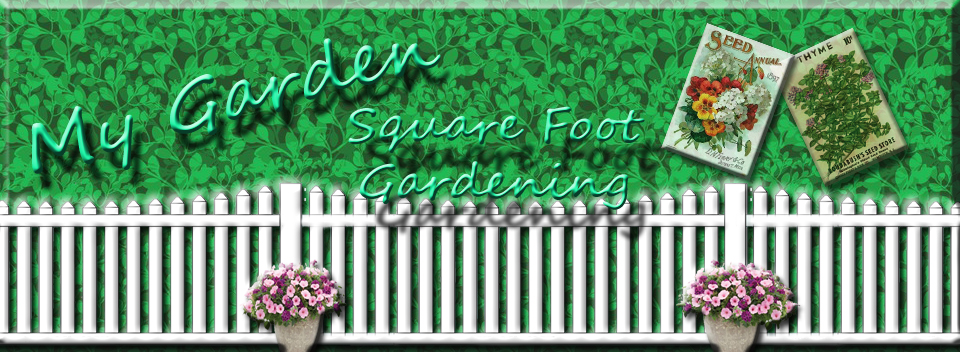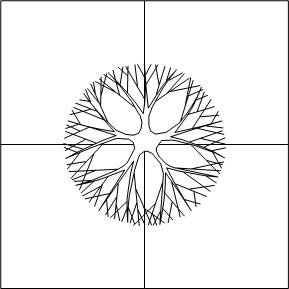
Square Foot Gardening
What is Square Foot Gardening?
Square Foot Gardening is a simple concept. The name come from the fact hat you grow your garden in raised beds that are based on even measurements of so many feet by so many feet. An example would be a raised bed that is 2 feet deep by 8 feet long. The beds are raised for two reasons. 1) Because you add soil to the raised beds instead of just growing in beds you dig in your yard, you an control what goes into that soil from the start. 2) Because the beds are raised and the depth is always shallow enough so you can get to all your plants, you never have to walk on soil and the soil always stays uncompacted. Most Square Foot beds are 1 to 4 feet deep. If the beds can only be reached from one side then the 1 or 2 foot rule applies where as if the beds can be reached from both sides then the beds can be 3 or 4 feet wide based on your ease of reach.
What materials can be used to construct a Square Foot bed?
Most beds are constructed from 2" X 6", 2" X 8", 2" X 10" or 2" X 12" inch boards but people have also made them with brick, block, and even from old tires. The garden I built last year I used 3 layers of Landscape Timbers. This year I decided to build the new garden with 2" X 8" X 8' lumber. I was going to use 2" X 6"s but for a few cents more I went with the extra 2 inches in height.
Can vegetables grow in only 6 inches of soil?
The answer is YES they can. If you think about a old typical way of gardening, you would turn over the soil manually or with a tiller. how deep would the shovel or tiller reach? about 6 inches deep. So as you can see, most gardening is done in the top 6 inches of soil. If you can afford to to get wider boards or even stack the boards in layers the that is even better but if all you can build is 6 inch high beds, they will work just fine.
Can I use Pressure Treated wood?
If you talk to some people they will say NO, NEVER! I did the research before I chose my materials and found one report to be very balanced and fair. The report (LINK HERE) basiclly said if that is all you have to work with then it is fine because the new rules for Pressure Treated wood have banned the use of arsenic that was used in Pressure Treated woods 20 years ago. Today Pressure Treated wood uses copper and a fungicide that is used in pools. If the copper was to leach into the plants, the plants would die before you could eat them. I chose to use Pressure Treated wood for my garden because I have to live on a budget and if I had to choose between a garden made from redwood at 5 times the price or not having a garden at all, the garden would still be non-existent. I believe most people are in the same boat as I am and cannot afford to build a $300.00 eight-foot bed when it can be built with Pressure Treated wood for under $25.00. Of course you could use non-Pressure Treated wood but it will rot very quickly. I being a bit paranoid chose to rap the Pressure Treated wood in thick plastic before I built the beds just as a extra precaution.
To see my garden bed design click on this link
How many plants do I grow per square foot?
Plant spacing is where Square Foot Gardening really starts to shine. It makes planting and Crop rotation so easy. All seed packs will come with a recommended plant spacing. An example is Carrots have a 3 inch spacing suggestion. If you go by the chart below you will see that a 3 inch spacing means you can plant 4 rows of 4 plants each for a total of 16 plants per square foot. Head Lettuce on the other hand has a plant spacing of 12 inches which mans that you can only plant one head per square foot.
Each square =
one square foot.

|
|||
| 12 inch spacing | 6 inch spacing | 4 inch spacing | 3 inch spacing |
| 1 plant per square | 4 plants per square | 9 plants per square | 16 plants per square |
There are some exceptions to the above rule. An example to this rule are some Tomato plants requite more room then a 12 inch spacing. I planted my Tomatoes at a 1 plant per 4 square feet.
Each square =
one square foot.

|
| 24 inch spacing |
| 1 plant per 4 squares |
Here is a list of suggested plant spacing per square foot.
| Plant | # Per Square | Plant | # Per Square | |
| Basil | 4 | Lettuce, head | 1 | |
| Beans, bush | 9 | Mustard greens | 16 | |
| Beans, pole | 8 | Okra | 1 | |
| Beets | 9 | Onions, storage | 4 or 9 | |
| Carrots | 16 | Onions, green | 16 | |
| Celery | 1 | Oregano | 1 | |
| Chives | 9 | Parsley | 1 | |
| Cilantro | 9 | Parsnips | 16 | |
| Collard greens | 1 | Peas | 8 | |
| Corn | 3 | Peppers | 1 | |
| Cucumbers | 2 | Potatoes | 1 | |
| Dill | 1 | Radishes | 16 | |
| Eggplant | 1 | Rosemary | 1 | |
| Garlic | 4 or 9 | Rutabagas | 4 | |
| Kale | 1 | Spinach | 9 | |
| Kohlrabi | 4 | Sweet potatoes | 1 | |
| Leeks | 4 or 9 | Swiss Chard | 4 | |
| Lettuce, leaf | 4 | Turnips | 9 |
Here is a list of suggested plant spacing for plants that require more then square foot per plant.
| Plant | Spacing | # of Squares |
| Broccoli | 18″ | 4 per 9 squares |
| Brussels sprouts | 18″ | 4 per 9 squares |
| Cabbage | 18″ | 4 per 9 squares |
| Cantaloupe | 24″ | 2 with trellis |
| Cauliflower | 18″ | 4 per 9 squares |
| Pumpkins | 24″ | 2 with trellis |
| Summer squash | 24″ | 4 with cage |
| Tomatoes |
12″ 24″ 36″ |
1 with stakes 4 with cage 9 no support |
| Watermelon | 24″ | 2 with trellis |
| Winter Squash | 24″ | 2 with trellis |
| Zucchini | 24″ | 4 with cage |
There are some plants that are not the best fit for growing in a Square Foot garden because they are evasive or require deep roots. These plants are better off being grown in their own pots. Here is a list of these plants
| Plant | Reason it is not good for Square Foot Gardening |
| Artichoke | They require 48 inch spacing or 1 plant per 16 squares |
| Asparagus | They require soil that is 18 inches deep |
| Mint | It is very invasive and will take over the whole garden. |
| Rhubarb | They require soil that is 18 inches deep |